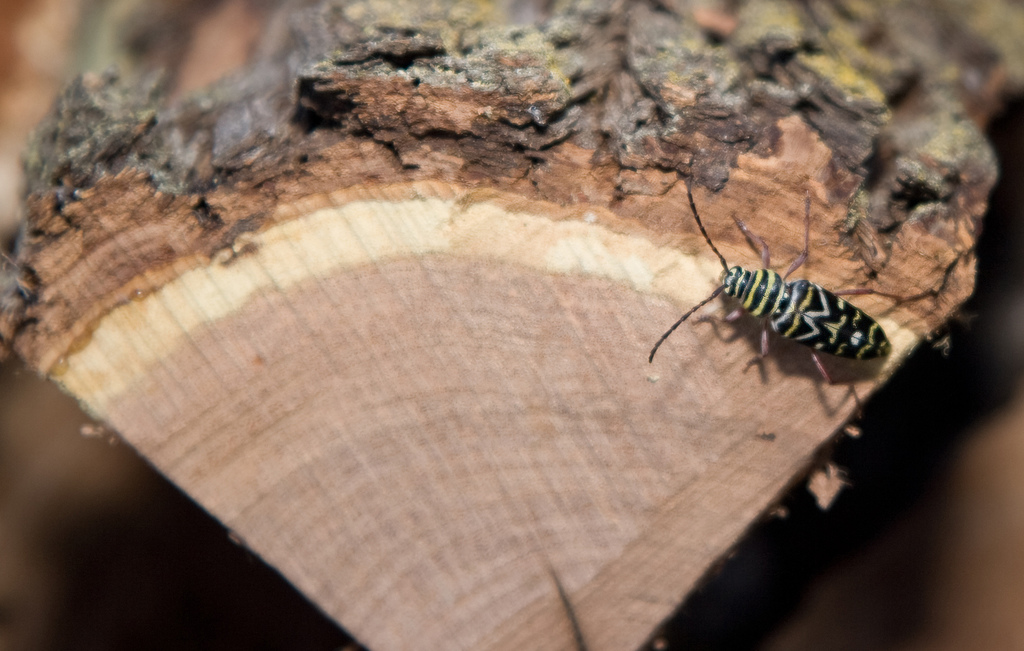Firewood bugs me
It’s economical, sustainable and keeps you in shape, not to mention that nothing feels as good as a seat by the woodstove on a sub-zero night. What’s not to like about heating with wood?
Certain things do bug people. The mess, for one. Stacking and splitting can get old. Adjusting the ‘thermostat’ may involve a trip outside to the woodpile. And occasionally, unexpected guests arrive.

Locust borer in the firewood. Photo: Susan Adams, Creative Commons, some rights reserved
Firewood, I’ve discovered, comes from “trees” which are covered in “bark,” under which insects can live and thrive. As the wood you bring inside warms up, it feels like winter’s over to these critters, who sally forth gleefully. Insects and homeowners are inevitably both disappointed.
The good news is you can take steps to discourage critters from making your woodpile their condo to begin with. Also, most of these guests are merely a nuisance. The bad news is, well, they’re a nuisance. The two types of firewood crawlies are shelter seekers and wood borers. Both kinds of stowaways usually head for a window where you can let them out or…whatever you want to do with them.
Shelter-seekers just need a place to crash for the winter. They’d be as happy under brush or leaves as in your firewood pile. These include wooly caterpillars, ladybird beetles, and non-insects like spiders and centipedes.
Wood borers range from less than one-eighth up to three inches long, but most are on the small side. The largest are roundheaded borers. The pine sawyer and its similar, sinister cousin the Asian longhorn beetle are examples. Flatheaded borers include the bronze birch borer and the invasive emerald ash borer. Like all bark beetles, the ambrosia and elm bark beetles are small and don’t enter the actual wood.
With some notable exceptions, wood borers seek dying or just-killed trees, sometimes arriving to lay eggs hours or minutes after a tree is felled. They rely on the phenol signature of a dead or dying tree, and they don’t need social media to keep up on news. They do need moisture, though, which plays into control options.
If conditions are right, it’s possible for particular insects to cause trouble. Tiny powderpost beetles (one-sixteenth of an inch) can infest bare hardwood in high-moisture environments. In the heating season your living space is too dry for them to survive. But firewood stored in a warm basement could be an issue if the joists are unpainted hardwood, which is sometimes the case in very old homes. Carpenter ants also need moisture to set up housekeeping. Unlike termites, they can’t eat wood, and can only make nests where moisture has initiated decay.
No matter what kind of wiggly passenger you see on firewood, never treat it with insecticide. Burning insecticide-treated wood poses a real health risk to those in the home.
The key to critter prevention is this: If they’re not in your firewood, they’re not getting inside. And they only like firewood if it’s damp. Seasoned wood that’s been stored off the ground and out of the weather is less likely to harbor insects. Keeping firewood out of garages and basements is highly recommended—ideally it should be stored away from the house in a non-attached structure.
If you cut your own wood, timing can help. Trees cut between late autumn and early spring, especially if the wood is split right away, are less likely to garner wood-boring insect eggs. However, even if insects get a start, they’ll perish when the wood is fully dry.
For more information contact your Extension office. In St. Lawrence County, call (315) 379-9192 or email ph59@cornell.edu. We’ll help you work the bugs out of heating with wood.
Paul Hetzler is a horticulture and natural resources educator with Cornell Cooperative Extension of St. Lawrence County.
Tags: energy, environment, insects, pests







